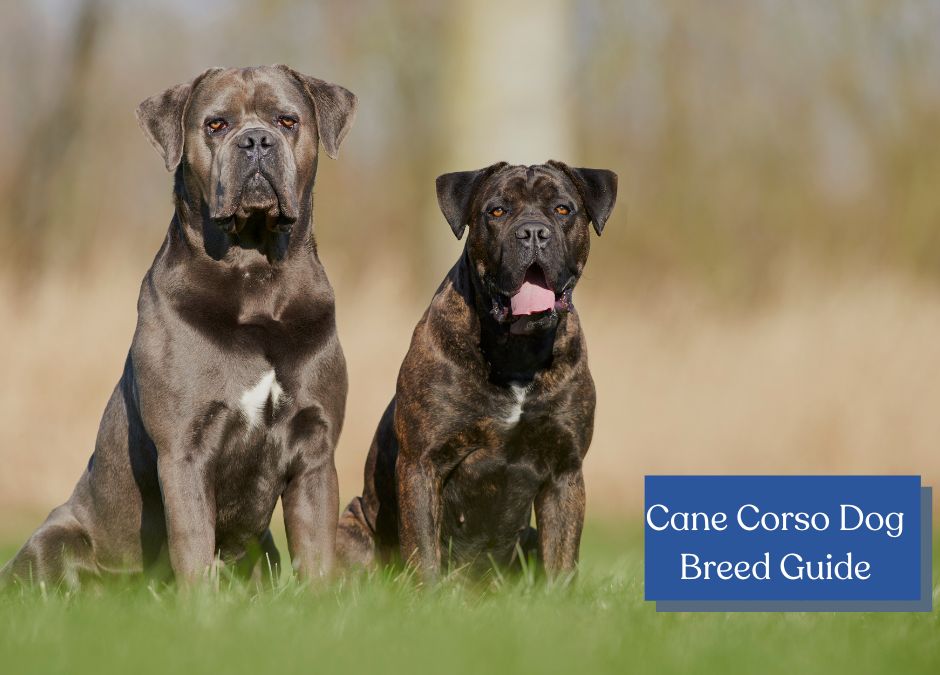Cane Corsos (aka Italian Mastiffs) are one of the most intimidating breeds on this planet. Their large build, strength, and formidability make them a popular choice for people wanting a guard dog to protect their homes. It’s a role Cane Corsos will excel at with the right owner.
But their protective instincts are only a tiny part of their make-up. If you’re considering adopting one, you must be ready for everything that comes with having this powerful dog in your home. This guide will help determine if you’re ready for this commitment. So please, read on and find out if the Cane Corso is the right breed for your family!
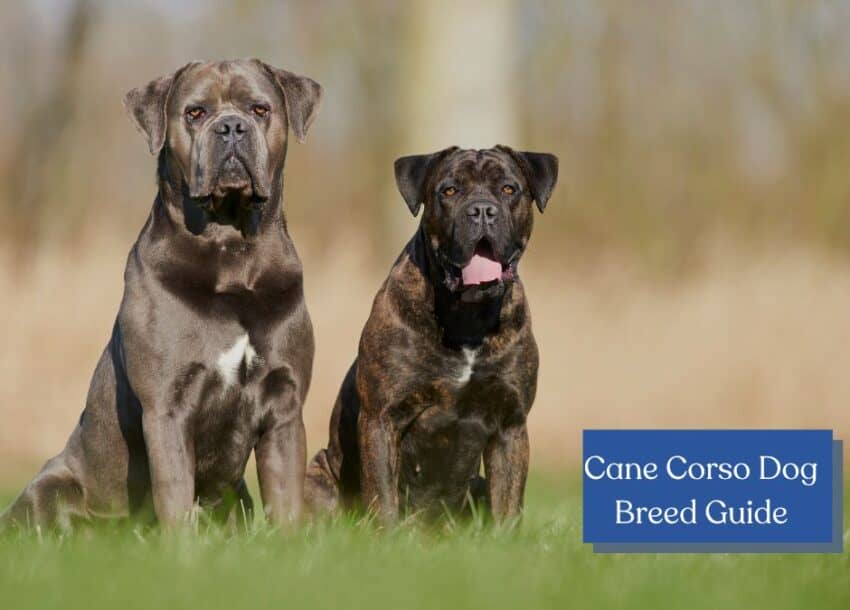
Complete Guide to the Cane Corso Dog Breed
The first thing to know about Cane Corsos is they’re considered pure breeds. In other words, these dogs aren’t a combination of any two dogs. They’re strictly their own breed with a unique history, appearance, temperament, health issues, and other qualities. But don’t worry; I’ll cover all of these unique qualities below, starting with their origin story!
Cane Corso’s History and Origin
Cane Corsos have a rich history, starting back in Roman times. Believe it or not, these dogs are descendants of Roman war dogs. Considering their massive builds and strength, it’s not very difficult to believe.
But this interesting Italian origin was only the start for Cane Corsos. These dogs continued working as guard dogs for farms and properties well past when the Roman Empire dissolved. It was common to see them on hunts, even taking down larger animals like boars.
However, Cane Corsos didn’t do so well once the concept of industrialization started becoming popular. People began not needing these massive dogs for hunting or protection. It even got to the point where this breed became almost non-existent after the World Wars.
Luckily, Giovanni Bonnetti introduced the breed to Dr. Paolo Breber around 1973. It became Cane Corso’s saving grace. Breber gathered a few of them and started a breeding program, which allowed them to gain popularity.
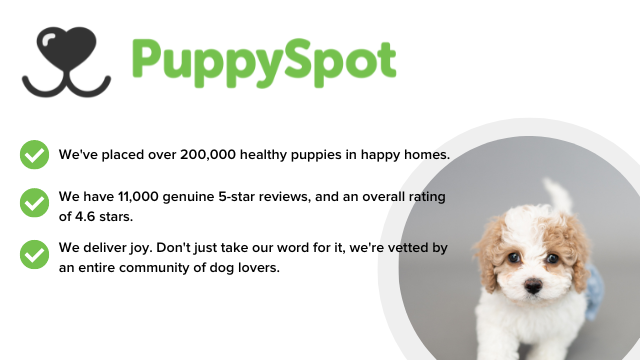
His hard work culminated in the FCI (Federation Cynologique Internationale) recognizing them as a breed in 1996. At this point, Cane Corso had made their presence known in various parts of the world. They even started to appear in the United States.
Finally, the American Kennel Club followed the FCI’s lead and recognized them in 2010. The breed’s journey was long, but they finally got a strong foothold. Their popularity has only grown since the AKC recognized them, especially in the US.
Cane Corso Physical Characteristics and Appearance
As a mastiff-type breed, its most immediate standout trait is its prominent figure. This breed’s size can almost be striking and intimidating when first seen. It’s common for non-dog owners to be a little scared by them.
A Cane Corso’s size also ensures it’s an extremely strong breed. Therefore, its long history of being a guard and hunting dog makes complete sense. It’s the last thing a thief wants to see when breaking into a house.
As for their appearance, Cane Corsos are identifiable by their massive, muscular builds. They may look intimidating, but they have a certain majestic quality—no wonder they’re becoming a more popular breed for pet owners.
Other standout traits include a wrinkly forehead and a massive head. You’ll also often see Cane Corsos with cropped ears, but this isn’t a natural trait. Sadly, it comes from humans chopping off parts of their floppy ears to make them seem scarier.
Cane Corsos vary greatly when it comes to color variations. I’ve seen the colors range anywhere from black to blue-gray. So owners can find a variation for their preferred preferences easily.
Of course, there’s a slew of other notable traits. So to avoid writing a 3000-word essay on their appearance, here’s a summary list of unique characteristics to cover the essentials:
Weight: 88 to 110 poundsHeight: 23 to 27 inchesNotable Features: broad chest, wide skull, floppy ears (but often cropped), and almond-shaped eyesCoat Type: short, double-layered fur coatAvailable Colors: black, slate, light gray, red, blue-gray, plumb-gray, pale fawn, deer fawn, and grayLifespan: 9 to 12 years
If you’re a visual person, check out this hilarious compilation video. It’ll give a much better idea of their size while showing off their fun-loving natures.
Cane Corso Temperament
Descriptions of Cane Corsos often start by alluding to their confidence and assertiveness. Both these qualities make them unafraid when facing almost all situations. Hence, their adept ability at providing protection and hunting.
But underneath this confidence lies a relatively gentle and affectionate side. It’s just a matter of providing the proper care and training to reach it. Due to this, Cane Corsos are a terrible choice for inexperienced or newbie owners.
Another hallmark trait of Cane Corsos is loyalty. These dogs are genuine pack animals and bond with their families deeply, much like an American Bull Terrier. But don’t expect them to extend these qualities to strangers or unknown animals.
Unlike American Bull Terriers, Cane Corso dogs aren’t known for being attention hogs. These pups enjoy their privacy and won’t be overbearing toward their owners. But Corsos love being pampered and spoiled with attention; it’s just not their only priority, like with other breeds.
Instead, these dogs simply want to hang out with their owners. They enjoy constantly being by their owner’s side rather than on their laps. Plus, it makes them more able to monitor potential threats, such as the mailman!
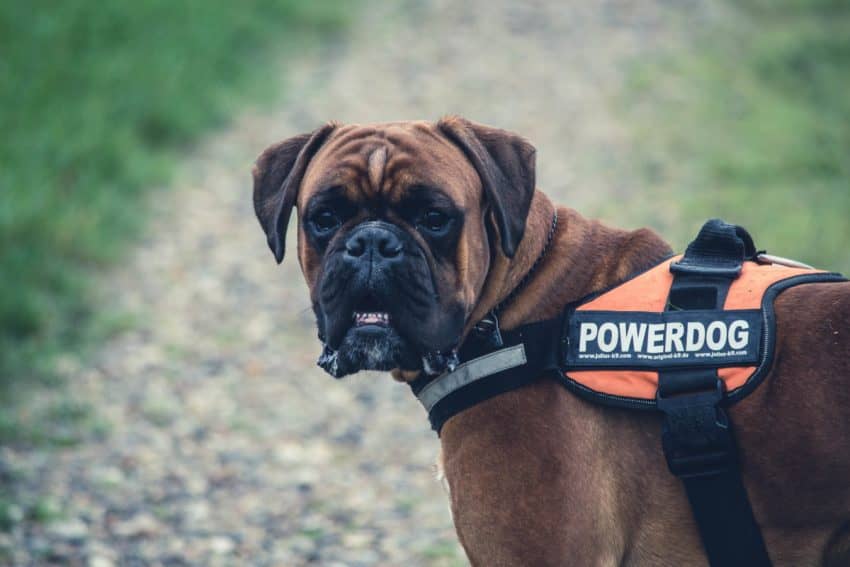
Are Cane Corsos Easy to Train?
Cane Corsos have a bit of a reputation for being challenging to train. The difficulty stems from their confidence and assertiveness, making them stubborn. So they’ll take advantage of anyone who isn’t confident with their training.
Basically, they require an experienced dog owner to train them properly: someone with an established background in dog training and behavior techniques. If that sounds like you, you shouldn’t have much problem teaching them commands and tricks.
After all, Cane Corsos are an intelligent breed. So there will be little limit on what they can learn with a proper trainer. But even with an experienced trainer, starting the lessons as soon as possible is essential. Their stubborn personalities will take hold if you wait too long. It’ll then become tough to get them out of their established routines.
A good starting point for training would be around ten weeks. Your Cane Corso should be more than capable of picking commands even at this young age.
One last note: PLEASE make sure you stick with positive reinforcement techniques. Negative techniques (including “be the alpha” nonsense) are counterproductive and can actually make dogs more aggressive. That’s a problem with any breed, but it’s downright deadly when you have a dog as powerful as a Cane Corso.
Common Health Issues for Cane Corso
Cane Corsos have a few health conditions that are more prone to contracting. It comes from their purebred status, which often has more medical complications than mixed breeds. But in particular, their larger builds bring forth most of these common issues.
So without further ado, let’s quickly discuss these common ailments. It’ll help potential owners prepare for what may cause them issues down the line:
1. Hip Dysplasia
Hip dysplasia is a common condition among larger dog breeds. This issue presents itself during a Cane Corso’s growth state, resulting in the loosening of their hip joints. It’ll cause them significant pain and dysfunction and eventually lead to arthritis.
Some common symptoms include lameness, issues with jumping, sitting in abnormal positions, and limping without a previous injury. It would be wise to schedule a vet visit if these symptoms present themselves.
You can also help prevent and ease symptoms by using a really good joint supplement, like Hemp & Hips Plus CBD by Veterinary Naturals, and investing in a great orthopedic dog bed.

2. Bloat
Bloat is a word no large breed dog owner wants to hear. It refers to when a dog’s stomach twists after consuming its dinner or water too quickly. At first, it’ll cause them abdominal pain while it shuts off the blood supply to the stomach.
If untreated, this condition can become a severe medical emergency. It can even become fatal if a vet does not address it within an hour or two. So large dog owners must be extra cautious about letting their dogs inhale their meals and water.
An easy way to avoid bloat is by separating meals into multiple sessions. Doing so will help calm your dog down a bit and slow down the consumption. Leaving water out all day long is also advisable for the same reason.
3. Ectropion
The last common health issue is a condition called ectropion. It refers to when a Cane Corso’s eyelids roll inwards, which causes them to rub against their eyes. This situation becomes very unpleasant and uncomfortable for your dog.
Moreover, it can cause damage to their eyes and affect their vision. So it’s vital to address the issue quickly if it does occur.
Exercise Requirements for Cane Corso
Cane Corsos require a significant amount of exercise to remain happy and healthy. It shouldn’t be too surprising, considering their working breed classification. But honestly, the extensiveness of these requirements can make certain owners unfit.
For instance, these dogs require daily exercise of at least 30 minutes to meet their needs. Most owners will use a mile walk or jog to fulfill these standards. But regardless, it’s the minimum of what a Cane Corso will need to provide each day.
I suggest throwing in a couple of longer exercise sessions per week. They could hike up a nearby trail for an hour or something else that gets their legs moving. An intense play session in your backyard would work, as well. Cane Corsos love playing frisbee or chasing a tennis ball around a yard.
Another important note is Cane Corsos excel when they’re given a job. It’s why these dogs would be excellent herding dogs around a farm. They would ensure your livestock is kept in line when transporting them.
But if they don’t have a job, Cane Corsos can get a bit restless. It may result in them tearing apart furniture or digging holes in your yard. In most cases, these behaviors will also stop with an extensive exercise regimen.
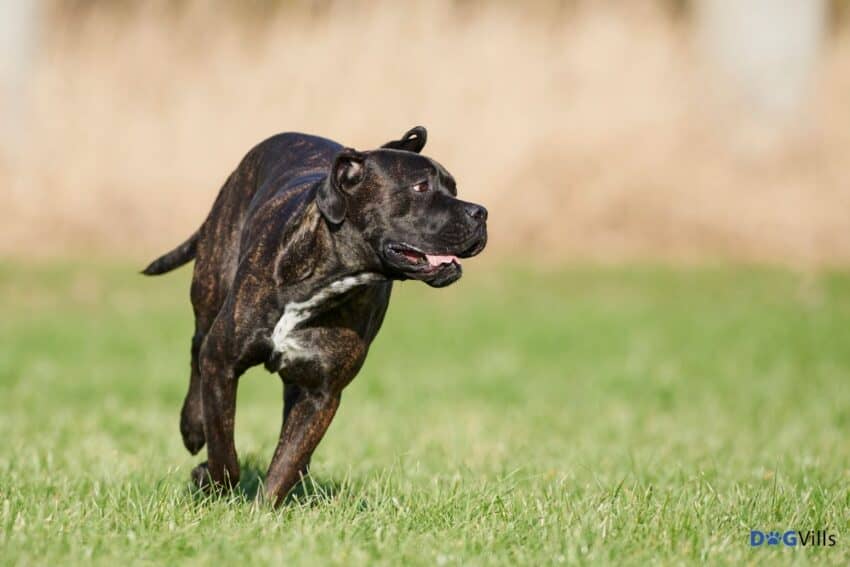
Grooming Requirements for Cane Corso
Keeping up with Cane Corso’s grooming requirements is manageable. A weekly brushing should be fine during most times of the year. But it should be upped to twice a week within the shedding season (spring and fall). In doing so, their short and coarse double coats shouldn’t cause their owners many problems.
As for bathing requirements, Cane Corsos only need them when necessary. So a bath would be a good idea if they roll into some feces. Otherwise, there isn’t much need for them to be given a bath under normal circumstances.
Nail care is another area where Cane Corsos don’t need much help. Their nails often wear down naturally when walking on pavement or similar surfaces. But it’s vital to watch them to ensure they don’t get too long. If they do, it’ll be time to take out your trusty nail clippers or take them to a groomer.
Lastly, check their ears for build-ups and other issues regularly. It’s an easy way to prevent infection or other issues from occurring. If you notice a build-up, use a vet-approved ear-cleaning solution to deal with the problem.
Cane Corso FAQs
Is Cane Corso More Aggressive than Pitbull?
Cane Corsos are more prone to aggressive behaviors than breeds considered “Pitbulls,” such as American Bull Terriers and Staffordshire Bull Terriers. But it’s something that proper training and socialization can handle.
Why Are Cane Corsos So Expensive?
Cane Corsos are more expensive than most dogs because they aren’t overly common. So their higher price is a byproduct of them being a rare breed. Breeders will use them being rare to their advantage and hike up the prices.
Is a Cane Corso Naturally Aggressive?
Cane Corsos aren’t naturally aggressive dogs. But they can become aggressive if they aren’t appropriately socialized or abused by their owners. It’s not any different from most other canines, except their size makes it more vital.
Conclusion
Overall, Cane Corsos are a breed best left for experienced owners with a dog training background. These owners will have the talent to deal with their larger size and stubborn personalities. More importantly, they’ll be able to bring out their gentle and affectionate side.
Pin this post for later:
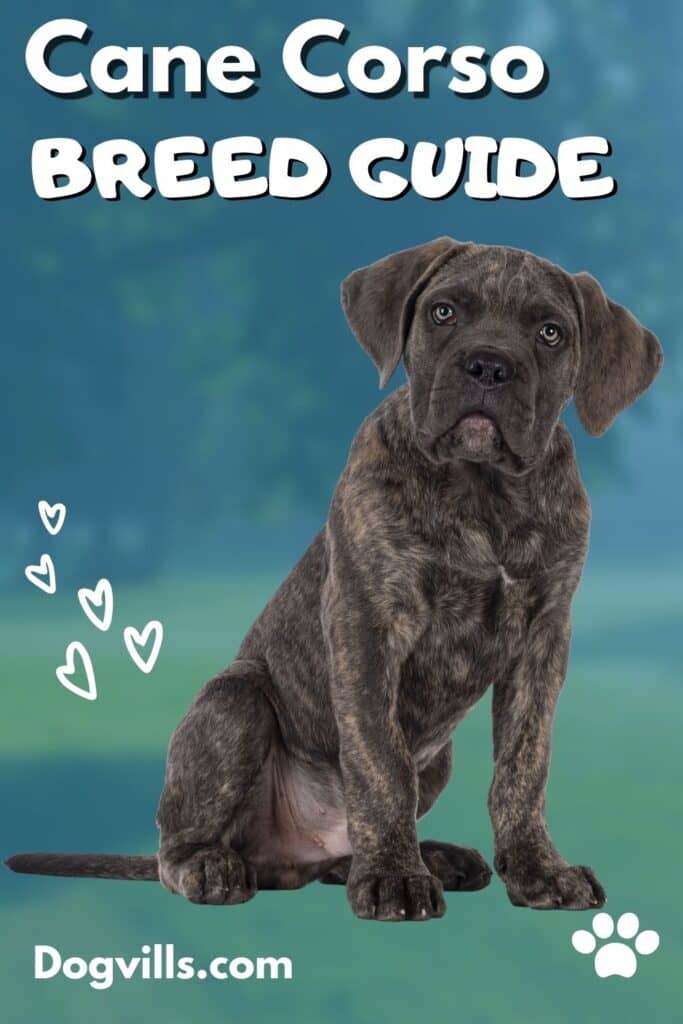
Do you have a Cane Corso? Let me know in our comment section if you have more questions or thoughts about this remarkable breed. I’d love to continue this conversation and help you decide whether they’re a good fit. Thanks for reading!

